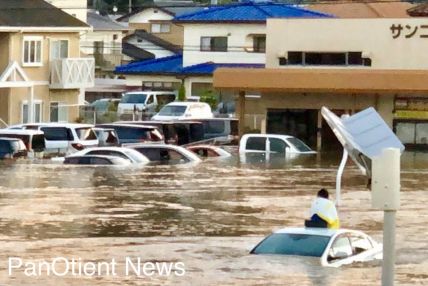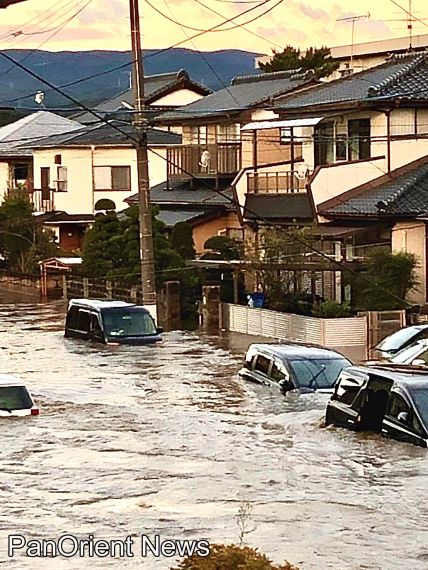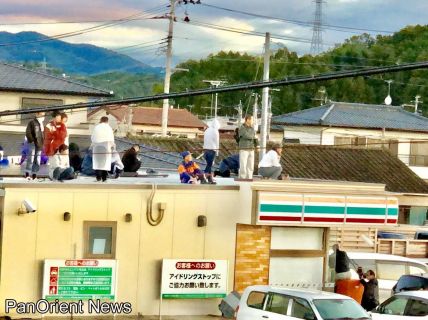|
|
Environment
Latest Assessment of the Effects of Typhoon Hagibis in Japan
Monday, October 14, 2019

Tokyo- (PanOrient News) The death toll from Typhoon Hagibis, which hit 13 prefectures in central, eastern and northeastern Japan on Saturday, has reached 55 people, with 16 still lost and about 100 injured as of Monday night, a new toll said. Most of the victims were drowned in rivers or buried alive.
Four of 12 crew members were rescued by the coastguard from a Panamanian cargo ship that sank in Tokyo Bay on Sunday morning. In addition, mudslides caused by the typhoon have left more than a hundred injured.
While search-and-rescue operations continued, latest data said there were 48 landslides in 12 provinces, as well as the flooding of 37 rivers, which led to the collapse of barriers on the banks of some of them.
As of Sunday afternoon, power was still cut off to 95,000 homes in Chiba Prefecture and 18,000 in the Tohoku region northeast of Tokyo. Hundreds of people have been left homeless and stranded by flooding, including residents of Setagaya in Tokyo, where the Tama River flooded nearby streets.

In addition, the water supply to over 82,000 homes in 14 prefectures was disrupted, especially in Miyagi and Ibaraki Prefectures, according to information released by Japan’s health ministry. The city of Iwaki in Fukushima Prefecture saw a water outage that affected 45,000 households, resulting from a local water purification facility being inundated by a flooding river.
Measures of rainfall reached 1,000 millimeters in Hakone, a town near Tokyo known for its monuments and natural sites.
As of the middle of the day on Monday, about 38,000 people in 17 prefectures had evacuated their homes, according to the Fire and Disaster Management Agency. According to the same government agency, there was an evacuation advisory in place for about 760,000 people in eight prefectures as of Monday morning, with about 38,000 people taking shelter.
Expressing concern about the prolonged economic effects of the typhoon, Japanese Prime Minister Shinzo Abe on Monday said that his government will establish a cross-ministry group to provide livelihood support for those afflicted. Abe also told government workers to do their best to aid in search and rescue activities.

About 110,000 people have been mobilized in response to the disaster, including some 27,000 troops from the Japan Self-Defense Forces, Japan Coast Guard officials, police and firefighters. Helicopters and boats from the Self-Defense Forces are also being used for disaster relief.
While the Meteorological Agency canceled the top-level hazard warning on a 5-level scale, it announced that Typhoon Hagibis was heading away from northeastern Japan at 60 kilometers per hour and with an atmospheric pressure at its center of 980 hectopascals and a maximum speed of 30 meters per second, sometimes increasing to 45 meters per second.
Commercial and service departments and transportation networks on highways, railways and airports, including the international airports of Haneda and Narita near Tokyo, began resuming business, which was almost completely suspended on Saturday.
The central and eastern districts of Tokyo have survived the effects of rain and winds, but most commercial, consumer and service sectors were closed on Saturday and Sunday morning, leaving Tokyo looking like a semi-deserted city.

Police said that among the dead were a man who died in his car, which flew up into the air and landed upside-down due to a sudden wind in Chiba Prefecture, a man whose house collapsed under a landslide in Gunma Prefecture, a man in his sixties who drowned inside his home in Kawasaki Prefecture, a woman washed away by floodwaters, and four people who died in their car that sank in a flood in Tochigi Prefecture. In Saitama prefecture near Tokyo, a 69-year-old woman was found floating dead on a bridge.
In addition, a 77-year-old woman in Iwaki, Fukushima Prefecture fell to her death as Tokyo Fire Department rescue workers attempted to save her by helicopter. The woman fell from about 40 meters up after workers were unable to successfully attach a hanger to the harness holding her.
The missing include three people in a car that fell into the Chikuma River from the bridge it was crossing in Nagano Prefecture, as well as a 60-year-old man in Tome, Miyagi Prefecture who left his home telling his family that he wanted to get out of the typhoon but did not return.
The Japanese use the name “typhoon” for the weather phenomenon known elsewhere as a hurricane or tropical cyclone, and the meaning of Typhoon Hagibis in the Philippine language Tagalog is "speed."
According to experts, some of the extent of damage from super typhoons like Hagibis can be attributed to global warming. One reason is that ocean heat acts like fuel for tropical storms, contributing to their rapid intensification, Meteorologist Philip Klozbach of the University of Colorado, USA, said. Another is that global warming has led to a slower global circulation of summer air, making tropical storms travel slower and causing more concentrated rainfall and wind damage in affected areas. (Pan Orient News)
© PanOrient News All Rights Reserved.
|
|




